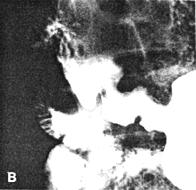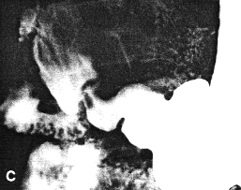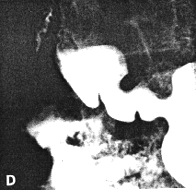



Go to chapter: 1 | 2 | 3 | 4 | 5 | 6 | 7 | 8 | 9 | 10 | 11 | 12 | 13 | 14 | 15 | 16 | 17 | 18 | 19 | 20 | 21 | 22 | 23 | 24 | 25 | 26 | 27 | 28 | 29 | 30 | 31 | 32 | 33 | 34 | 35 | 36 | 37 | 38 | 39
Chapter 29 (page 141)
In a further study of the pathomorphology of the antropyloric wall in peptic ulcer disease,
Liebermann-Meffert and Allgöwer (l98l) found that abnormalities of the muscle
fibres and Auerbach's plexuses, and the replacement of contractile muscular tissue by
fibrous tissue, might impair antropyloric motor function, having a bearing on gastric
emptying and duodenogastric reflux. The changes were always more severe in gastric
than in duodenal ulceration, and did not occur in controls. While the pyloric aperture was
somewhat rigid to distension in all peptic ulcer patients, its mean diameter was not
significantly smaller than in controls and there was no stenosis of the pyloric ring which
could account for gastric stasis.
Miller et al. (l980) pointed out that while patients with Type I gastric ulcers had less acid
in their stomachs than normal controls, it was debatable whether this indicated actual
hyposecretion, or whether it was due to increased back-diffusion of hydrogen ions across
the mucosal barrier, or to neutralization by refluxed duodenal contents. In a study of 7
patients with chronic benign gastric ulceration above the incisura, it was found that
gastric acid output in response to an ordinary solid-liquid meal was significantly less than
in normal controls. In the patient group the emptying rate of solids was consistently
lower than in controls while emptying of liquids remained normal. The gastric ulcer
patients also had increased intragastric bile acid concentrations.
In his review Brooks (l985) found that a gastric ulcer in the corpus was usually associated
with hyposecretion of acid and pepsin, decrease in the "antral" gastrin content, reduced
amplitude of "antral" contractions, an incompetent pylorus, increased bile reflux, and
delayed emptying of solids.
We have noted that gastric ulcers in the more proximal parts of the stomach were
sometimes associated with contraction or motility disturbances of the pyloric sphincteric
cylinder. The following are representative cases:
Case Reports
Case 29.1 C.W., 60 year old male, presented with intermittent epigastric pain and
malaena. Radiographic examination showed a gastric ulcer, 2.5 cm in diameter, in the
posterior wall of the upper corpus, approximately 10 cm proximal to the pylorus; the
features were those of a benign ulcer. There was constant contraction (or spasticity) of
the pyloric sphincteric cylinder, the contracted region being 3.0 to 4.0 cm in length (Fig.
29.1). Cyclical contraction and relaxation of the cylinder, normally occurring at a rate of
3 cylces per minute, was absent; the contraction of the cylinder "fixed" the pyloric
aperture in the open or patent position. Mucosal folds in the contracted cylinder appeared
normal, but their movements were restricted. A shallow, concave identation of the base
of the duodenal bulb, caused by the pyloric ring, was evident. Peristaltic waves in the
remainder of the stomach were normal; emptying of liquid barium appeared normal.
Two weeks later a Billroth I partial gastrectomy confirmed the large, chronic gastric
ulcer. No macroscopic abnormality was seen or felt in the pyloric region. Histology of
the ulcer proved it to be benign; microscopic examination of the pyloric region was not
carried out.
 |  |
 |  |
| Fig. 29.1 A-D.
Case C.W. Constant contraction or spasticity of pyloric sphincteric cylinder. Cyclical
activity absent. Pyloric aperture "fixed" in patent position (B-D)
|
Previous Page | Table of Contents | Next Page
© Copyright PLiG 1998










